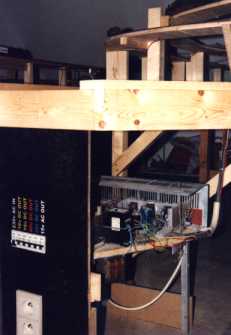
Power Central
The electric 'power plant'
The
first real construction for the layout was this large electric power supply:
Using a classic system of fuse -> Transformer -> rectifier -> condenser
the power sources were build.
There were various voltage levels required for the layout:
· 15v DC, at least 20 amps for trains and controllers
· 12v AC, at least 8 amps for model lights
· 48v DC, at least 3 amps for the turnout drivers (I once used recycled
telephone central relays for these)
· 5v DC, at least 3 amps for digital controls
· 22v DC, at least 1.5 amps for control panel LED's
 |
 |
Each output has its own fuse, to protect the (expensive) rectifiers and transformers
from being destroyed when short-circuit occurs.
I had to actually buy only one transformer: for the 15V/20A train-power I chose
a 400VA transformer, used for halogen lights (this provides 11.6V/32A AC and
is not too expensive). The other components I recycled from previous projects
or old electronic equipment (like some audio amplifiers). The large condensers
where recycled from the same sources. Only the bridge rectifiers were bought.
I never used such heavy (50v/20amps) ones before.
A lot of attention went to security: the wires I used
are quite thick (e.g. the common mass output has a 1/6 inch section!). High-voltage
outputs (the mains voltage and the 48v DC) were protected from accidental touching.
A large metal cap was placed over the rectifiers and condenser: I wouldn't like
a peace of metal, like a tool or so, to fall in between and cause damage.
This heavy power central can't be simply connected to the mains voltage: because
of the large current it draws when being switched on, it could cause contacts
to get burned and even the mains fuse to be destroyed. I therefore chose a large
relay, controlled by a switch on the main control
panel.
In November '03 a recycled computer power supply was added, so I had some extra
power voltage: +12v/1,5A, -12v/1,2A, and 5v/9A I needed the +5V mainly, for
various system controllers, and - as seemed later - for the turnout drivers.
The 48V for the turnout drivers I used before, became obsolete...
| ©2005 Gerolf Peeters -
updated
07.11.2005
|
See: Safety |


